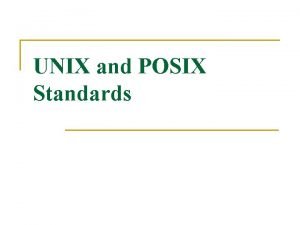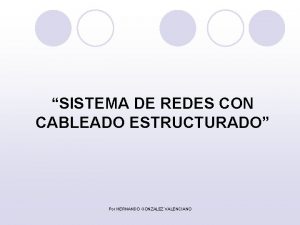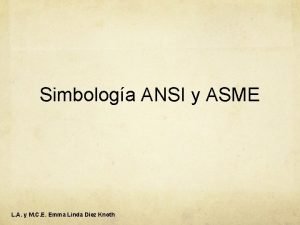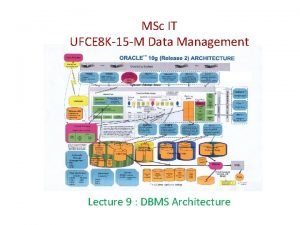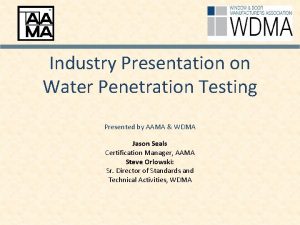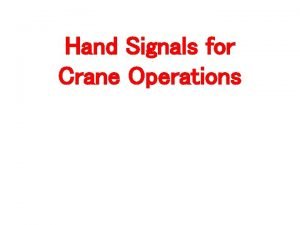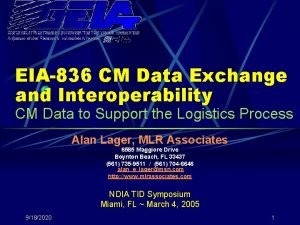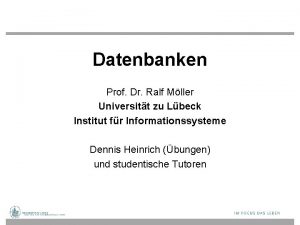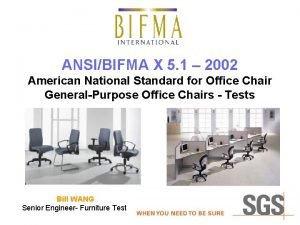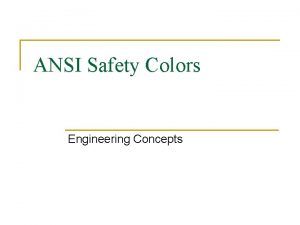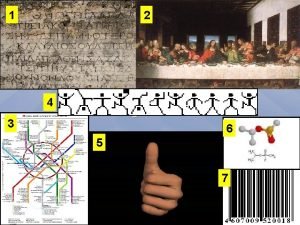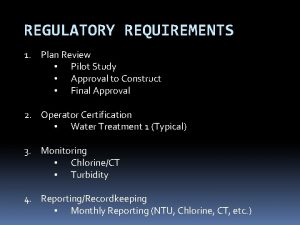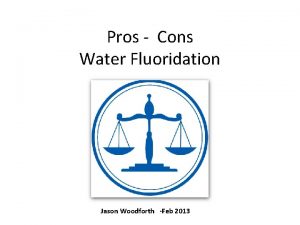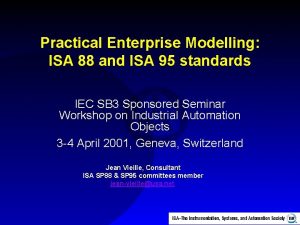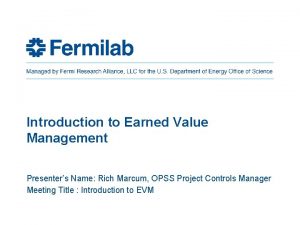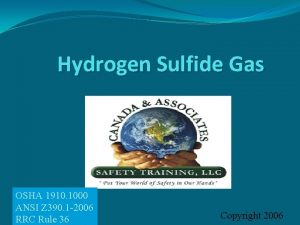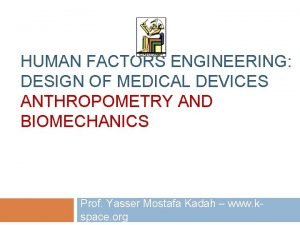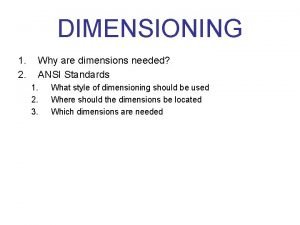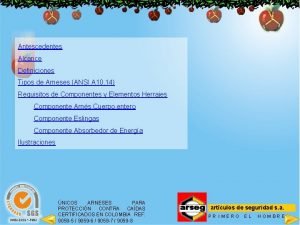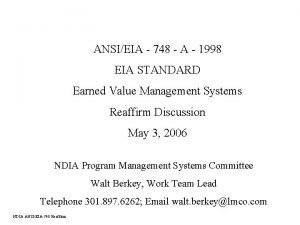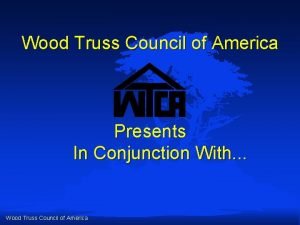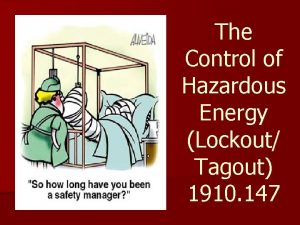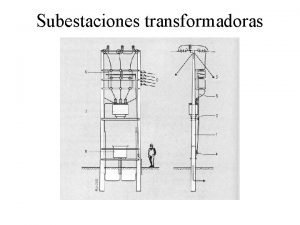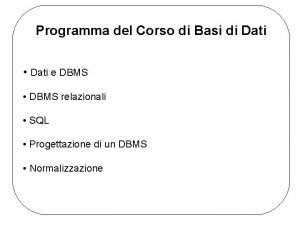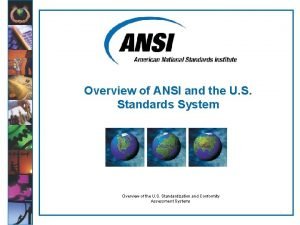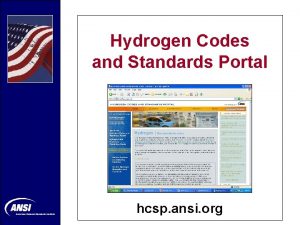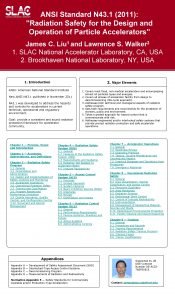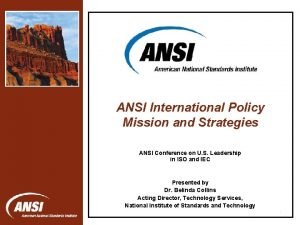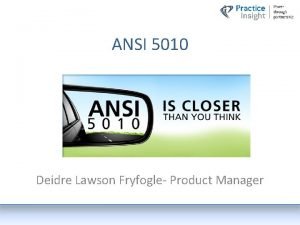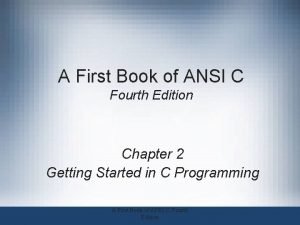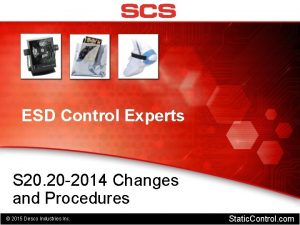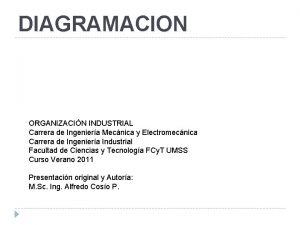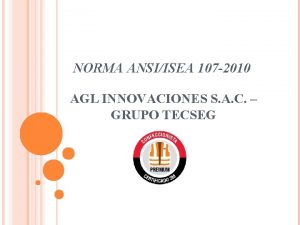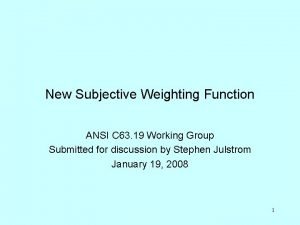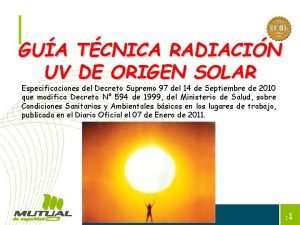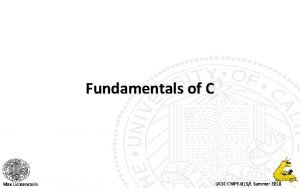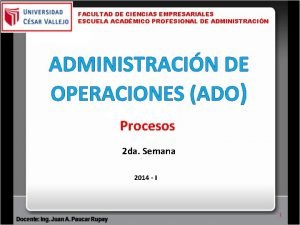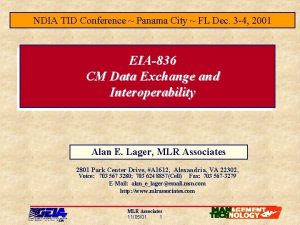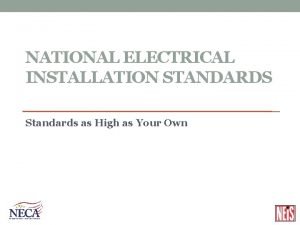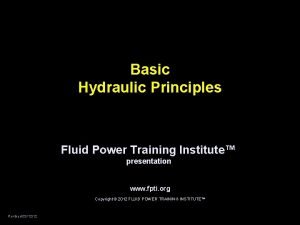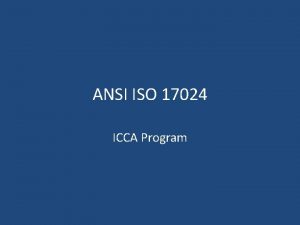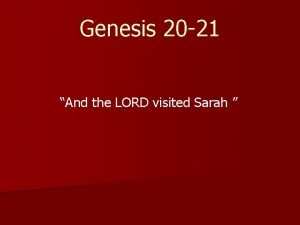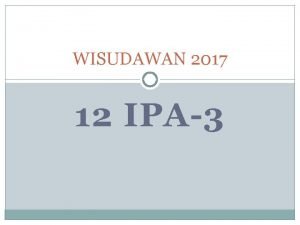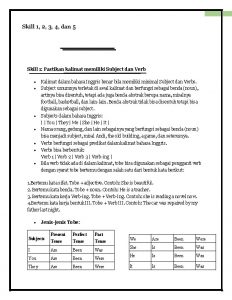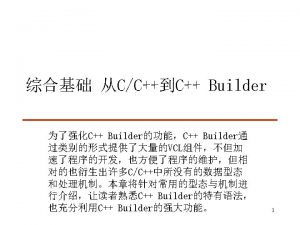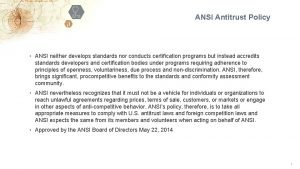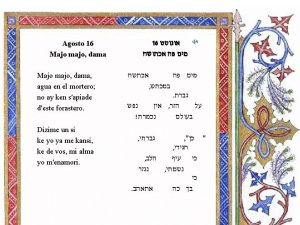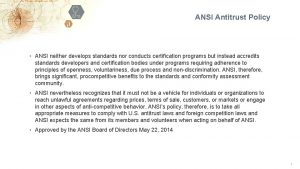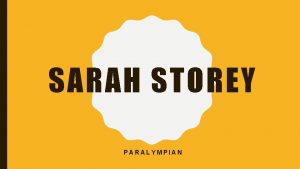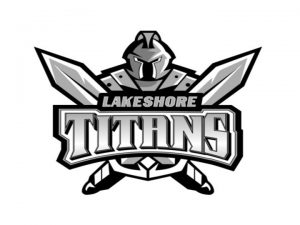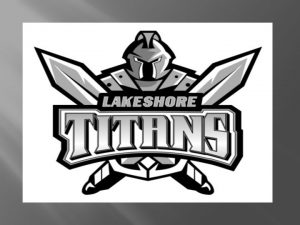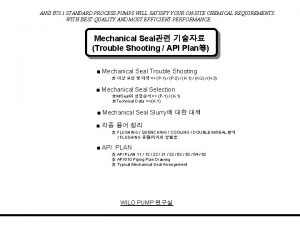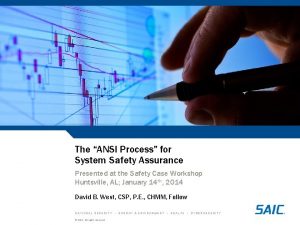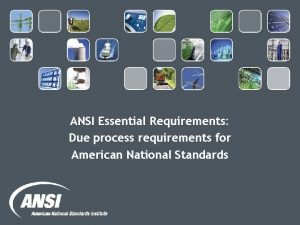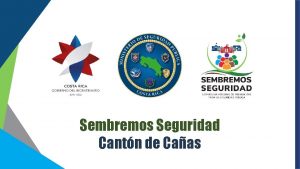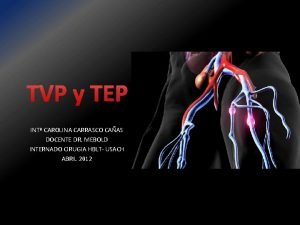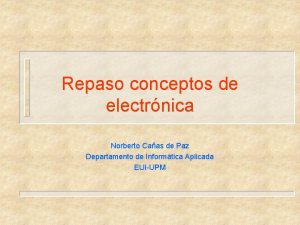CAAS and the ANSI Process Sarah L Mc

























































































































- Slides: 121


CAAS and the ANSI Process Sarah L. Mc. Entee Executive Director, CAAS

CAAS -vs- GVS CAAS Accreditation Standards: • Standards for enhancing quality and performance for licensed ambulance service providers • Established in 1990 • “Gold Standard”- exceeds state EMS licensure requirements • Voluntary, or as required by state/county or local ordinance • When met- the ambulance service/organization is granted accreditation • www. caas. org

CAAS -vs- GVS v. 1. 0 Ground Vehicle Standard: • Standard for the design of new ambulances • Establishes minimum standards, performance parameters and essential criteria for the design of ambulances • Provides a practical degree of standardization • When built to the GVS standard- the vehicle will bear the GVS logo • www. groundvehiclestandard. org

CAAS -vs- GVS • • Two separate standards One is not a requirement for the other Both follow the same process for standard development American National Standards Institute – ANSI

American National Standards Institute (ANSI) • Private, independent nonprofit organization • Founded in 1918 • Facilitates the development of voluntary consensus standards • Official US representation to International Organization of Standardization (ISO)

ANSI- Essential Requirements and Due Process • Facilitates the development of American National Standards (ANS) by accrediting the procedures of Standard Developing Organizations (SDO’s) as Accredited Standards Developers (ASD’s) • SDO’s are required to adhere to a set of requirements called “ANSI Essential Requirements” • Due Process- key to ensuring that all ANS’s are developed in an environment that is: • Equitable • Accessible • Responsive to the requirements of its various stakeholders

ANSI- Essential Requirements and Due Process • The standards development process should have a balance of interests. • Participants from diverse interest categories shall be sought with the objective of achieving balance. • Public review and comment periods are made available and accessible

CAAS and GVS ANSI Status • Currently an ANSI member • CAAS is ANSI accredited as a National Standards Developer • Both CAAS accreditation standards and GVS standard development processes currently follow ANSI guidelines and requirements • Both standards have been submitted to ANSI for American National Standards (ANS) designation - GVS v 1. 0 submitted, contested by NFPA, currently in mediation efforts - CAAS v 3. 0 submitted, no comments received, progressing • Both standards are scheduled for review/revision in 2017 and 2018

GVS Development and Status Mark Postma GVS Co-Chair, CAAS

GVS Development Committee of 36 individuals -Industry stakeholders, government members, vehicle and personnel safety experts, ambulance users, purchasers, vehicle and equipment manufacturers Convened in DC - Held 10 two-day meetings over 15 months Opened twice for public comments Approved by consensus body vote Published March 2016/ Effective July 2016

GVS v 1. 0 Standard • Standard for the design of new ambulances • Establishes minimum standards, performance parameters and essential criteria for the design of ambulances • Provides a practical degree of standardization • Effective July 2016 • When built to the GVS standard- the vehicle will bear the GVS logo • Does not require or imply CAAS accreditation which is a separate program • www. groundvehiclestandard. org

GVS v 1. 0 Standard • GVS documentation foundation is KKK • Applicable to new production vehicles only • Accommodates current chassis offerings • Maintains certain important quality criteria • Includes new NIOSH/SAE Safety Standards • Allows purchaser flexibility with consideration for local requirements

What is Not Included in GVS v 1. 0 • Vehicle speed limitation • Unproven technical feature requirements • Mandates for exterior graphics -color/configuration • Reduced quality of electrical system • Reduced structural integrity of patient compartment floor • Ability for FSAM to “self certify” ambulances to standard

What is Included in GVS v 1. 0 • Purchaser ability to define emergency lighting configuration • Purchaser ability to define exterior graphics design and colors • Continuity of KKK enhanced electrical system requirements“Class 3 Life Support” • Continuity of KKK enhanced floor structure and loading requirement (AMD 20) • New defined minimum payload requirement of 1, 300 pounds for every vehicle including options

What is Included in GVS v 1. 0 • Ability for purchaser to deviate from standard as allowed by state, exceptions to be defined by FSAM • Additional enhancements are suggested, not required • Required compliance for all AMD testing standards #01 -25. • FSAM required to provide Type Testing and Certification for each ambulance model from certified independent testing facility.

Required Safety Features GVS includes new safety requirements that are fully researched and proven by NIOSH: • SAE 3026 Patient Compartment Seating • SAE 3027 Litter Fasteners and Anchorage • SAE 3043 Ambulance Equipment Mounting and Retention • Change order 8 to KKK 1822 F incorporates SAE 3026 and 3027 with effective date of July 1, 2015 for new builds Additional NIOSH/SAE requirements will be included in future revisions of the GVS standard as they are published

Future plans for GVS v. 1. 0 • Three (3) year revision plan is scheduled • Additional SAE standards to be included as they are published • Pediatric standards for patients and passengers • Standards for remounts to be addressed

2015 • KKK CN#8 • Cot/mount • Seats 2016 • KKK CN#9 • Eq. Rest 1 2017 • KKK CN#10 • Cabinets • Body • Floor • Excursion • Eq. Rest 2 • Remounts Ahead • Pediatric • Remounts www. safeambulances. org

NASEMSO Perspective Michael Berg NASEMSO

Remount Forum June 7, 2017 Position Statement

Position Statement As we support the coexistence of the GVS v 1 and the NFPA 1917 Ambulance Standards, we also support and encourage participation in any process that addresses patient and provider safety through, science, technology, and research. We welcome the opportunity to be an active participant in the creation of standards for remounted ambulances.

Questions? Michael D. Berg, BS, NRP Chair, AVL Committee National Association of State EMS Officials michael. berg@vdh. virignia. gov

Certification and Compliance- FMVSS Coleman Sachs NHTSA Office of Compliance

NHTSA Requirements for Ambulance Body Remounters Presentation for the Commission on Accreditation of Ambulance Services (CAAS) Ground Vehicle Standard (GVS) Remount Forum - June 7, 2017 Harris Conference Cntr Charlotte, NC Coleman Sachs, Chief, Import and Certification Division National Highway Traffic Safety Administration

NHTSA • • • 26 A small agency in the U. S. Department of Transportation established in 1966 Mission is to improve safety on nation’s highways and reduce fatalities and injuries associated with vehicle crashes Issues the Federal motor vehicle safety standards (FMVSS) Prescribe minimum safety performance requirements for motor vehicles and for certain items of motor vehicle equipment All FMVSS found in 49 CFR Part 571. Each has a number. FMVSS 208 Occupant Crash Protection is at 49 CFR 571. 208. Currently there are 64 FMVSS; 49 are vehicle standards; 15 apply to motor vehicle equipment such as tires, rims, brake hoses, brake fluid, seat belt assemblies, lighting equipment, and glazing.

Statutory Prohibition • 49 U. S. C. 30112(a) provides that no person shall manufacture for sale, sell, offer for sale, introduce or deliver for introduction in interstate commerce, or import into the United States any motor vehicle or motor vehicle equipment manufactured on or after the date an applicable FMVSS takes effect unless the vehicle or equipment complies with the standard and is covered by a certification under 49 U. S. C. 30115 27

Certification, Statutory Requirement • 49 U. S. C. 30115 requires a motor vehicle to be certified to the FMVSS by permanently affixing a tag or label to the vehicle by the time of its delivery to a distributor or dealer.

Is an Ambulance Body Remounter a Manufacturer? • Yes. NHTSA’s regulations at 49 CFR 571. 7(e) provide that when a new cab is used in the assembly of a truck, the truck will be considered newly manufactured for the purpose of applying the National Traffic and Motor Vehicle Safety Act of 1966 and the Federal motor vehicle safety standards unless the engine, transmission, and drive axle(s) (as a minimum) of the assembled vehicle are not new, and at lest two of these components were taken from the same vehicle.

What kind of a manufacturer is an ambulance body remounter? • • An ambulance body remounter is a Final-Stage Manufacturer. NHTSA’s regulations at 49 CFR 567. 3 define a “chassis-cab” as an incomplete vehicle with a completed occupant compartment that requires only the addition of cargo-carrying, work-performing, or load-bearing components to perform its intended function. The same regulations define a “final-stage manufacturer” as a person who performs such manufacturing operations on an incomplete vehicle that it becomes a completed vehicle. A “completed vehicle” is defined as a vehicle that requires no further manufacturing operations to perform its intended function

Do Ambulance Body Remounters Have Certification and other Responsibilities under NHTSA’s Regulations? • Yes, as a final-stage manufacturer, an ambulance body remounter assumes legal responsibility for all certification-related duties and liabilities under the Vehicle Safety Act, except to the extent that the incomplete vehicle manufacturer or an intermediate manufacturer has provided equipment subject to a safety-standard or expressly assumed responsibility for standards related to systems and components it supplied and except to the extent that the final-stage manufacturer completed the vehicle in accordance with the prior manufacturers’ incomplete vehicle document or IVD or any addendum to that document. See 49 CFR 567. 5(d)

Must an ambulance body remounter affix a certification label to the completed vehicle? • Yes. As a final stage manufacturer, an ambulance body remounter must affix a certification label to each vehicle in a manner that does not obscure the labels affixed by previous stage manufacturers and that contains the following statements: – Name of the final stage manufacturer, preceded by the words “MANUFACTURED BY” OR “MFD BY” – Month and year in which the final stage manufacture is completed , spelled out, as in “June 2000, ” or expressed in numerals, as in “ 6/00” – Gross Vehicle Weight Rating, followed by the appropriate value in kilograms and (pounds), which shall not be less than the sum of the unloaded vehicle weight, rated cargo load, and 150 pounds times the number of the vehicle’s designated seating positions.

Certifications Requirements, Continued – Gross axle weight rating, followed by the appropriate value in kilograms and (pounds) for each axle, identified in order from front to rear (e. g. front, first intermediate, second intermediate, rear). Example: Front- 5, 215 kg (11, 500 lb) with 295/75 R 22. 5(G) tires – One of the following alternative certification statements: • “This vehicle conforms to all applicable Federal Motor Vehicle Safety Standards in effect in (month, year). ” • “This vehicle has been completed in accordance with the prior manufacturer’s IVD, where applicable. This vehicle conforms to all applicable Federal Motor Vehicle Safety Standards in effect in (month, year)”

Certification Requirements, Continued • “This vehicle has been completed in accordance with the prior manufacturer’s IVD, where applicable, except for [insert FMVSS(s)]. This vehicle conforms to all applicable Federal Motor Vehicle Safety Standards in effect in (month/year). ” • The date shown in the above statements shall not be earlier than the manufacturing date provided by the incomplete or intermediate stage manufacturer and not later than the date of completion of the final-stage manufacture. The certification label must also identify the vehicle’s vehicle identification number or VIN and the vehicle’s type classification, such as “truck. ”

Certification Label

Certification • Performed by the manufacturer and not NHTSA (no type approval) • Manifested by a label permanently affixed to the vehicle in a prescribed location • Identifies the manufacturer, the date of manufacture, the vehicle type • States that the vehicle complies with all applicable FMVSS in effect on the date of manufacture shown above 36

Location of Label • The label must be affixed to either the hinge pillar, door-latch post or the door edge that meets the door latch post, next to the driver’s seating position, or if none of these locations is practicable, to the left side of the instrument panel. If that location is also not practicable, the label shall be affixed to the inwardfacing surface of the door next to the driver’s seating position. If that too is not practicable, the manufacturer must provide notification to NHTSA with a suggested alternative location. 49 CFR 567. 4(c). 37

Certification • The manufacturer must exercise “reasonable care” in certifying a vehicle to an applicable standard. • If NHTSA suspects a noncompliance, it will ask the manufacturer to demonstrate how it exercised “reasonable care. ” • Tests are prescribed in many of the standards; these are NHTSA’s notice of what it will do to determine compliance. The manufacturer is free to demonstrate compliance by other means

Certification Requirements (Continued) • If the manufacturer fails to demonstrate that it exercised “reasonable care” in certifying the vehicle or equipment item to the standard in question, it is subject to civil penalties • Penalties are currently set at $21, 000 per violation, up to a maximum penalty of $105, 000 for a related series of violations • A separate violation exists with respect to each vehicle or equipment item that does not comply

Procedural Requirements Before offering its vehicles for sale in the United States, a vehicle manufacturer must: • Identify itself and its products to NHTSA pursuant to 49 CFR Part 566 Manufacturer Identification • This information is submitted to, and published on NHTSA’s website at https: //vpic. nhtsa. dot. gov. • For further information contact NHTSA at 1 -888 -3993277 or at manufacturerinfo@dot. gov. 40

Responsibility for Defects or Noncompliances • • • As a final stage manufacturer, an ambulance body remounter is responsible for any safety-related defect or noncompliance with a Federal motor vehicle safety standard in the components or equipment it adds to the vehicle or that it introduces into the vehicle as a result of the work it performs. The final stage manufacturer must furnish NHTSA with notice of the defect or noncompliance under 49 CFR Part 573 Defect and Noncompliance Information Reports within five days of discovering the defect or noncompliance The final stage manufacturer must also furnish owners of the vehicle with notification of the defect or noncompliance under 49 CFR Part 577, and a remedy for the defect or noncompliance without charge if the vehicle was purchased less than 15 years from the date the manufacturer furnishes notice of the defect or noncompliance to NHTSA.

NHTSA Office of Defects Investigations & Special Crash Investigations • • • The NHTSA ODI conducts safety defect investigations and analyzes safety issues in motor vehicles and equipment. Three-pronged mission: – Identify design or manufacturer defects; – Assure defects are remedied promptly and effectively; and, – Assure information relating to defect investigations and safety recalls is readily available to the public The NHTSA SCI program provides NHTSA with in-depth crash investigation data which is collected from basic police crash reports and comprehensive special reports by crash investigation teams. Final reports include: – Pre-crash activities of the persons involved; – Contributing factors to serious or fatal injuries sustained in a crash; – Environmental or roadway factors; and, – Vehicle and equipment factors More information can be found at www. NHTSA. gov or www. EMS. gov

Internet Resources • For information on NHTSA’s importation and certification program: www. nhtsa. gov/cars/rules/import. Information on that site includes a detailed list of answers to frequently asked questions. • A handbook for new motor vehicle or equipment manufacturers can be downloaded at: https: //vpic. nhtsa. gov/Manufacturer_Handbook_20161019. pdf • The database identifying all manufacturers who have registered with NHTSA and given us VIN-deciphering information is at: https: //vpic. nhtsa. dot. gov/mid/ 43

Contacts • • Import and Certification Division tel: (202) 366 -5291 fax: (202) 493 -0073 e-mail: importcertification@dot. gov Coleman Sachs (Division Chief) tel: (202) 366 -3151 e-mail: coleman. sachs@dot. gov 44

Multi-stage Vehicles Steve Spata NTEA

CAAS-GVS Remounted Ambulance Forum Presenter: Steve Spata, Technical Assistance Director, NTEA

CAAS-GVS Remounted Ambulance Forum • Certification process • Compliance • Documentation • Resources

Certification Process • What is certification? Your company’s representation that a vehicle you manufacture meets all applicable Federal Motor Vehicle Safety Standards (FMVSS) • Different than “certification” to ‘Triple K Spec’, NFPA or CAAS • Labeling — Last step in certification process

Certification Process • Applies to all new motor vehicles ‘pre-owned’ body New vehicle New chassis

Certification Process Two things to keep in mind: 1. All vehicles must be certified in the final stage (i. e. , All vehicles have to be manufactured to a condition where they meet all of the FMVSS that apply). 2. All manufacturing operations performed on motor vehicles prior to the first purchase (meaning licensed and titled in some State) must be certified (i. e. , All stages of manufacturing that a vehicle goes through require a form of certification and labeling that corresponds to that stage).

Certification Process • Steps include: weight distribution, review of Incomplete Vehicle Document (IVD) and body builder information, compliance analysis and documentation, requesting compliance representations from equipment/system suppliers, etc. • FMVSS applicability can include vehicle type, number of designated seating positions and gross vehicle weight rating (GVWR)

Certification Process • Ambulances classified as “multipurpose passenger vehicles” (MPVs) • Up to ~50 FMVSS that apply to MPVs

Compliance • Incomplete Vehicle Documents

Compliance • Incomplete Vehicle Documents

Compliance Conformity Statements • Type I • A statement that the vehicle, when completed, will conform to the standard if no alterations are made in identified components of the incomplete vehicle. • Type II • A statement of specific conditions of final manufacture under which the incomplete vehicle manufacturer specifies that the completed vehicle will conform to the standard. • Type III • A statement that conformity with the standard cannot be determined based upon the components supplied on the incomplete vehicle, and that the incomplete vehicle manufacturer makes no representation as to conformity with the standard.

Documentation Develop compliance rationale • Review IVD conformity statements applicable FMVSS • Determine if Standards met within OEM guidance or if additional testing/analysis is necessary • Save in files

Documentation Develop compliance rationale • Weight, in particular, plays a critical role in meeting certain FMVSS, especially vehicles < 10 K lbs. GVWR (also needed for ‘Triple K’ compliance) • Maximum unloaded vehicle weight (Max UVW), Distribution of weight/Center of Gravity • Newer emission regulations include UVW and frontal area limitations

Documentation Labels for Final Stage Certification for vehicles completed from Chassis Cab, Cutaway or incomplete Van “This vehicle has been completed in accordance with the prior manufacturers' IVD, where applicable. This vehicle conforms to all applicable Federal Motor Vehicle Safety Standards, [and Bumper and Theft Prevention Standards, if applicable] in effect in (month, year). ”

Documentation Labels for Final Stage Certification for vehicles completed from Chassis Cab, Cutaway or incomplete Van • Additional label for vehicles with a GVWR of 10, 000 lbs. or less • Placard req’d under FMVSS 110

Resources • FMVSS https: //www. ecfr. gov • OEM Body builder websites • Suppliers • Test labs • Designate an internal ‘compliance champion’

Thank you! 37400 Hills Tech Drive, Farmington Hills, MI 48331 ǀ 800 -441 -6832 ǀ ntea. com ǀ info@ntea. com Requests for permission to reuse NTEA webinar content should be submitted to Joy Knesnik, NTEA communications manager, at joy@ntea. com.

Chassis Manufacturer Perspective Alex Jowa Ford QVM


Special Vehicle Engineering CAAS Remount Forum 6/7/17 Alex Jowa QVM Program Engineer Ford QVM Programs


QVM Programs Annual QVM Program Review § Documented Process Control § Documented Quality Control § Minimum Material Requirements § Customer Support § Completed Vehicle Underbody Inspection

QVM Programs § QVM Program Review is a Process Check § Ford does not “certify” the builders § Ford does not design or test builder's components , systems or “completed” vehicles

QVM Program Minimum Requirements D 0105 C/FMVSS and Emissions sign-off conducted annually for each model with written documentation D 0112 Builder registered with NHTSA/Transport Canada D 0113 Non-Pool Account Builder has provided proof of adequate liability insurance of $ 5 M

QVM Program Minimum Requirements D 0114 Emissions Certificate requirements reviewed Type: ____Dyno ___Chassis. Reviewed for compliance, and if required, additional pathway to compliance D 0306 "Four-corner" weight analysis conducted on each model.

QVM Program Minimum Requirements D 0603 Vehicle sign-off is complete and the Final Stage Manufacturer Label is checked for accuracy and installation. OEM label is not removed D 0607 A passenger/cargo capacity label is installed.

QVM Program Minimum Requirements D 0609 Inspection hoist or pit is available. E 0404 Engineering sign-off and FMVSS 105 compliance on revised spring rate or ride height

Transit Incomplete Vehicle Manual (IVM) § Available on web site www. fleet. ford. com/truckbbas under “Publications” § Max frontal areas § Max Vertical CG’s,

FMVSS 105 Compliance This vehicle when completed, will conform to Standard 105, Hydraulic and Electric Brake Systems, if no alterations, modifications, or replacements are made to the following: – Service or parking brake system – Antilock brake system – Vacuum system – Wheels and tires – Brake system indicator lamp and wiring – Brake system reservoir label is not to be obstructed by additional underhood components – Suspension ride height or spring rate* – Hydro-Boost system – Power Steering pump and lines if used with Hydro-boost – Engine belt drive system – Wheelbase

FMVSS 105 Compliance Aftermarket rear suspensions: If a final stage manufacturer modifies the suspension ride height or spring rate of the factory-equipped vehicle, then they are responsible for engineering analysis or physical testing to ensure compliance and sign-off to Standard 105

QVM Programs § QVM Contract Signed § Manufacturers that meet QVM Program requirements are recognized as “participants” and can advertise accordingly

Special Vehicle Engineering E-mail: bbasqa@ford. com Phone: 1 -877 -840 -4338 Web Site: www. fleet. ford. com/truckbbas

www. fleet. ford. com/truckbbas 11/29/2020 77

www. fleet. ford. com/truckbbas 11/29/2020 78

QVM Programs THANK YOU !


Overview of New SAE Test Methods Jim Green, NIOSH

“Star of Life” Ambulance Certification John Mc. Donald, GSA

Federal Specification for the Star-of-Life Ambulance Presented by: John Mc. Donald jmcdonald@gsa. gov

K Sticker “My ambulance just failed inspection. They said I need a new K sticker. I need you to send me one right away”

Where does the FMVSS say I have to have a “K” sticker? • It doesn’t • There is no Federal law requiring “K” stickers

1. 1. 3 “STAR OF LIFE” CERTIFICATION. The final stage ambulance manufacturer (FSAM) shall furnish to a purchaser an authenticated certification and label stating that the ambulance and equipment comply in effect on the date the ambulance is contracted for. with this specification and applicable change notices

FIGURE 1 – Certification & Payload Signage The label shall be mounted on the body (module) interior in a conspicuous location. • The label shown here is suggested format. • Deviations in dimensions are acceptable. • All text must be included. • Exceptions, when taken, shall be documented in the handbook of instructions • No text shall be added to this label • CERTIFIED “STAR OF LIFE” AMBULANCE • Date of • Manufacture________________________________ • Mfg By • ______________________________________ • Address • ______________________________________ • City_________________State____Zip _______ • This ambulance conforms to Federal Specification KKK-A-1822 in effect on the date the • ambulance was contracted for • Exceptions taken? No_____ Yes_____ • If exceptions are taken, they must be listed in the handbook of instructions and identified by • Section Number • • • • Final Stage Ambulance Manufacturers ID Number_____________________________ VIN _______________________________________ OEM Chassis Model, Year of Manufacture _____________________ Vehicle Type ________________________________ NOTICE: THIS VEHICLE, AS MANUFACTURED, CONFORMS TO THE PAYLOAD REQUIREMENTS OF THE FEDERAL AMBULANCE SPECIFICATION KKK-A-1822. USERS SHALL NOT LOAD VEHICLES ABOVE THE GVWR, GAWRs OR EXCEED THE TOTAL USABLE PAYLOAD OR CAPACITY LISTED BELOW. TOTAL USABLE CARGO/EQUIPMENT CAPACITY __________lbs. (Total remaining weight capacity of equipment and cargo evenly distributed in interior and exterior compartments the user may add)

Where do I get a New “K” sticker? • The final stage ambulance manufacturer (FSAM) shall furnish to a purchaser an authenticated certification and label stating that the ambulance and equipment comply with this specification and applicable change notices in effect on the date the ambulance is contracted for.

Who Regulates Ambulances in Your State? Not GSA Not NFPA Not ASTM Not CAAS Not DOT Your State EMS Director 11/29/2020 89

What Does My State Require? • Different in each state • Contact your state EMS Director BEFORE you remount, not after the ambulance is delivered • http: //www. safeambulances. org/ 11/29/2020 90

Virginia Remount Regulation NFPA Remount Standard Michael Berg VA Office of EMS NFPA Remount Committee

Remounted Ambulances Virginia Office of EMS

Virginia Emergency Medical Services Regulations “ 12 VAC 5 -31 -810. Ground Ambulance Specifications. B. A ground ambulance must be commercially constructed and certified to comply with the current federal specification for the Star of Life ambulance (U. S. General Services Administration KKK-A-1822 standards) as of the date of vehicle construction, with exceptions as specified in these regulations. ” http: //law. lis. virginia. gov/admincode/title 12/agency 5/chapter 3 1/section 810/

Paraphrase Opinion from AG Although there appears to be a difference between newly constructed ambulances and remounts, the regulations don’t make any such distinction. The regulation requires all ground ambulances to comply with the current federal specifications for the SOL ambulance. (June 20, 2016).

Questions? Michael D. Berg, BS, NRP Manager, Regulation and Compliance Virginia Department of Health Office of Emergency Medical Services michael. berg@vdh. virginia. gov (804)888 -9131

NFPA’s Ambulance Committee • The committee has begun to consider the best way to address the subject of ambulance remounts. • The committee is looking at two different options: • Include the material as part of the next edition of NFPA 1917 • Not include it as part of the next edition but develop a new standard on it • The committee made proposed changes to NFPA 1917 during its current revision cycle so they could address this at the second draft stage

NFPA’s Ambulance Committee • The committee also established a task group to study the best way to address this subject and report that back to the committee. • The task group, chaired by Michael Berg, reported back to the committee that there should be a new, separate, standalone document developed to address ambulance remounts. • The full committee is meeting in August, and anyone can attend, to further work on the task groups recommendation on remounts. • Further information can be found at www. nfpa. org/1917

NFPA’s Ambulance Committee • Contact information: • Dave Fischler, NFPA Ambulance committee chair, dfischler 30@aol. com • Michael Berg, Ambulance Remount TG chair michael. berg@vdh. virginia. gov • Ken Holland, NFPA staff liaison, kholland@nfpa. org • Visit www. nfpa. org/1917 for more information on the work of the committee responsible for NFPA 1917


CAAS GVS Remount Forum Open Group Discussion Topics

Fundamental Issues • Is the patient compartment of a remounted ambulance relevant to the year of the old chassis and body OR the year of the new chassis? – FMVSS requirements – Ambulance standards

Fundamental Issues • How do you address FMVSS requirements that relate to the patient compartment and are model year specific? – FMVSS 206 - Door Handles (2007) – FMVSS 207/210 – Seats and bases (2008) – FMVSS 209 - Seat Belt Assemblies

Fundamental Issues • If a remounter is adding or changing seats and/or belts, how do they verify compliance with the most current version of FMVSS requirements? • If a remounter is adding or changing door handles, how do they verify compliance with the most current version of FMVSS requirements?

Fundamental Issues • Does the KKK certification of the original vehicle by the FSAM have any relevance following a remount? • How do you balance customer specifications, FMVSS regulations and KKK/GVS/NFPA ambulance standards?

Remounter • • • Required to be registered with NHTSA Maintains product liability coverage? QVM member? ISO certified? NTEA/AMD member? Provides warranty coverage?

Process • Complies with chassis Incomplete Vehicle Manual (IVM) requirements for each chassis • Complies with Truck Body Builder Guide specific to chassis brand • Maintains appropriate compliance and engineering sign-off records • Maintains vehicle specific records relative to original and new body/chassis

Process • Performs engineering analysis for vehicle modifications. Examples: – Change in chassis model – Change in vehicle type (I to III or vice versa) – Change in body mounting – Change in body structure – Change in seating and belts – Change in litter retention system – Installation of crash nets – Change in or additional equipment mounting

Product • MUST comply with all FMVSS requirements • Do you provide any consideration for patient compartment safety requirements that may have been enacted after manufacture of original unit? Ex: – Occupant head clearance zone – Weight guidelines – payload and balance – Equipment restraint for O 2, monitor and fire ext. • Do you verify that the new chassis meets all requirements for the application?

Product • Are you offering addition of new CN #8 (2015) SAE features on remounts? – SAE J 3026 compliant seating – SAE J 3027 compliant litter retention – SAE J 3043 compliant equipment mounting • Does the original unit meet SAE minimum requirements of CN#10 (2017)? – SAE J 3057 Modular Body Integrity – SAE J 3058 Interior Cabinet Integrity – SAE J 3102 Floor Load

Product • Do you perform modifications on or install new systems that require FDA compliance? – Litter mount and cot – Cot restraint straps – Suction system • Do you perform any analysis or repair on litter mounts and cots that have been damaged by accident?

Product - Documentation • Do you provide required FMVSS compliance vehicle stickers? • Do you provide vehicle stickers showing original body information and including remount specific information for new unit? • Do you provide vehicle stickers with basic information on weight and payload, tire pressure, O 2 test, etc? • Do you leave original stickers on the unit?

Product - Documentation • Do you provide documentation showing information on original vehicle and remounted vehicle? • Do you provide an owner’s manual with important information on vehicle? Ex: – Operator manual for any furnished equipment – Warranty information – Weight and payload documentation

AMD Standards AMD standards are performance tests that work in conjunction with the Star of Life KKK specifications to verify that certain requirements of the specification are met. All AMD standards are in addition to, and in no way a substitute for FMVSS and other federal requirements that apply to all motor vehicles including ambulances.

AMD Standards • • AMD 001 AMD 003 AMD 004 AMD 005 AMD 006 AMD 007 AMD 008 Test Ambulance Body Structure Test O 2 Tank Retention System Test Litter Retention System Test Low Voltage Electrical Test Patient Compartment Sound Test Patient Compartment CO Test Patient Compartment Handrail

AMD Standards • • AMD 009 AMD 010 AMD 011 AMD 012 AMD 013 AMD 014 AMD 015 125 VAC Electrical Test Water Leak Test Equipment Temperature Test Interior Climate Control Test Weight Distribution Guidelines Engine Cooling System Test Main Medical Gas Test

AMD Standards • AMD 016 Test • AMD 017 • AMD 018 • AMD 019 • AMD 020 • AMD 021 • AMD 022 Patient Compartment Lighting Road Test Rear Stepping Surface Test Measuring Guide for Cabs/Compts. Floor Distributed Load Test Aspirator System Test Cold Engine Start Test

AMD Standards • AMD 023 • AMD 024 • AMD 025 Test • AMD 026 • AMD 027 Siren Performance Test Perimeter Illumination Test Occupant Head Clearance Zone Emergency Lighting Configuration Line Voltage Electrical Test

Modular Body Collisions • Do you do major body repairs involving structural damage? • How do you evaluate scope of damage and process of repair from a structural standpoint? – Major repairs can be poorly done or done by unqualified shops, driven by insurance carrier – Body structural integrity can be affected – Major body repairs may affect OEM body certification

Next Steps • Establish a Remount Standard Work Group to develop recommendations to be provided to CAAS GVS Comm. for consideration in GVS V. 2. 0. • Apply online at www. groundvehiclestandard. org • Work group will be designated through ANSI guidelines. Members will be balanced by principal activity of applicants. • First meeting tentatively to be held this fall, all are welcome to attend.

Questions?

 Lotero juliana
Lotero juliana Azure caas
Azure caas Ansi standard c
Ansi standard c Hình ảnh bộ gõ cơ thể búng tay
Hình ảnh bộ gõ cơ thể búng tay Frameset trong html5
Frameset trong html5 Bổ thể
Bổ thể Tỉ lệ cơ thể trẻ em
Tỉ lệ cơ thể trẻ em Gấu đi như thế nào
Gấu đi như thế nào Tư thế worm breton
Tư thế worm breton Hát lên người ơi alleluia
Hát lên người ơi alleluia Môn thể thao bắt đầu bằng từ đua
Môn thể thao bắt đầu bằng từ đua Thế nào là hệ số cao nhất
Thế nào là hệ số cao nhất Các châu lục và đại dương trên thế giới
Các châu lục và đại dương trên thế giới Công thức tính thế năng
Công thức tính thế năng Trời xanh đây là của chúng ta thể thơ
Trời xanh đây là của chúng ta thể thơ Mật thư tọa độ 5x5
Mật thư tọa độ 5x5 101012 bằng
101012 bằng độ dài liên kết
độ dài liên kết Các châu lục và đại dương trên thế giới
Các châu lục và đại dương trên thế giới Thể thơ truyền thống
Thể thơ truyền thống Quá trình desamine hóa có thể tạo ra
Quá trình desamine hóa có thể tạo ra Một số thể thơ truyền thống
Một số thể thơ truyền thống Cái miệng bé xinh thế chỉ nói điều hay thôi
Cái miệng bé xinh thế chỉ nói điều hay thôi Vẽ hình chiếu vuông góc của vật thể sau
Vẽ hình chiếu vuông góc của vật thể sau Nguyên nhân của sự mỏi cơ sinh 8
Nguyên nhân của sự mỏi cơ sinh 8 đặc điểm cơ thể của người tối cổ
đặc điểm cơ thể của người tối cổ V cc cc
V cc cc Vẽ hình chiếu đứng bằng cạnh của vật thể
Vẽ hình chiếu đứng bằng cạnh của vật thể Phối cảnh
Phối cảnh Thẻ vin
Thẻ vin đại từ thay thế
đại từ thay thế điện thế nghỉ
điện thế nghỉ Tư thế ngồi viết
Tư thế ngồi viết Diễn thế sinh thái là
Diễn thế sinh thái là Dot
Dot Thế nào là số nguyên tố
Thế nào là số nguyên tố Tư thế ngồi viết
Tư thế ngồi viết Lời thề hippocrates
Lời thề hippocrates Thiếu nhi thế giới liên hoan
Thiếu nhi thế giới liên hoan ưu thế lai là gì
ưu thế lai là gì Khi nào hổ mẹ dạy hổ con săn mồi
Khi nào hổ mẹ dạy hổ con săn mồi Khi nào hổ mẹ dạy hổ con săn mồi
Khi nào hổ mẹ dạy hổ con săn mồi Hệ hô hấp
Hệ hô hấp Từ ngữ thể hiện lòng nhân hậu
Từ ngữ thể hiện lòng nhân hậu Thế nào là mạng điện lắp đặt kiểu nổi
Thế nào là mạng điện lắp đặt kiểu nổi Bullerskada
Bullerskada Ansi/tia/eia-606-a
Ansi/tia/eia-606-a Simbología ansi para diagramas de flujo
Simbología ansi para diagramas de flujo Factbase definition
Factbase definition Ansi/sparc
Ansi/sparc Raphael mudge
Raphael mudge Lower boom hand signal
Lower boom hand signal Formalisme ansi
Formalisme ansi Ansi eia 836
Ansi eia 836 Konzeptionelles datenmodell beispiel
Konzeptionelles datenmodell beispiel Ansi sparc
Ansi sparc Arquitectura de un sistema de base de datos
Arquitectura de un sistema de base de datos Ansi/bifma x5.1
Ansi/bifma x5.1 Ansi sia
Ansi sia Ansi safety colors
Ansi safety colors 0000 0001 0010
0000 0001 0010 Nsf ansi 60
Nsf ansi 60 Fluoridation of water pros and cons
Fluoridation of water pros and cons Isa-88
Isa-88 Ndia ansi evms criteria matrix
Ndia ansi evms criteria matrix Physical properties of hydrogen sulphide
Physical properties of hydrogen sulphide Aami/ansi he75
Aami/ansi he75 Ansi dimensioning standards
Ansi dimensioning standards Standard engineering drawing scales
Standard engineering drawing scales Ansi a10.14
Ansi a10.14 Ansi eia 748
Ansi eia 748 Wood truss council
Wood truss council Fluxograma padrao ansi
Fluxograma padrao ansi 1910 lockout tagout
1910 lockout tagout Curva ansi
Curva ansi Architettura ansi sparc
Architettura ansi sparc Definisi pengukuran kinerja
Definisi pengukuran kinerja What is ansi annual budget
What is ansi annual budget Ansi z-10
Ansi z-10 Ansi.org
Ansi.org Elicitação de requisitos
Elicitação de requisitos Ansi 43
Ansi 43 Ansi mission
Ansi mission Ansi 5010
Ansi 5010 Ieee/ansi 830-1998
Ieee/ansi 830-1998 A first book of ansi c
A first book of ansi c Ansi/esd-s-20.20
Ansi/esd-s-20.20 Simbologia ansi
Simbologia ansi Cableado estructurado esquema
Cableado estructurado esquema Arsitektur database
Arsitektur database Simbología iso para diagramas de flujo
Simbología iso para diagramas de flujo Ansi 107-2010
Ansi 107-2010 Ansi 63
Ansi 63 Guía técnica radiación ultravioleta de origen solar
Guía técnica radiación ultravioleta de origen solar Ansi
Ansi Simbologia ansi diagramas de flujo
Simbologia ansi diagramas de flujo Eia-836
Eia-836 Ansi/neca 1-2015
Ansi/neca 1-2015 Ansi ü
Ansi ü Fluid power training institute
Fluid power training institute Ansi 17024
Ansi 17024 Sarah is selling bracelets and earrings
Sarah is selling bracelets and earrings Genesis 20:21
Genesis 20:21 Sarah and pam often go to parties
Sarah and pam often go to parties Figurative language trashketball
Figurative language trashketball Wellness and wellbeing with sarah glasgow
Wellness and wellbeing with sarah glasgow Abraham and sarah
Abraham and sarah The ins and outs of sarah
The ins and outs of sarah Sarah and angelina grimke apush
Sarah and angelina grimke apush Os coxae
Os coxae Coronoid and condylar process
Coronoid and condylar process Aisha nurtabina
Aisha nurtabina Sarah candrian
Sarah candrian John hottinger fairfield university
John hottinger fairfield university Sarah ruddock
Sarah ruddock Sarah stabile
Sarah stabile Sarah's uncle's car was found
Sarah's uncle's car was found Jakob blankitny
Jakob blankitny Mark brittain staying fat for sarah byrnes
Mark brittain staying fat for sarah byrnes Sarah couillard
Sarah couillard Sarah rarely misses her basketball shots
Sarah rarely misses her basketball shots Sarah thomas quotes
Sarah thomas quotes


